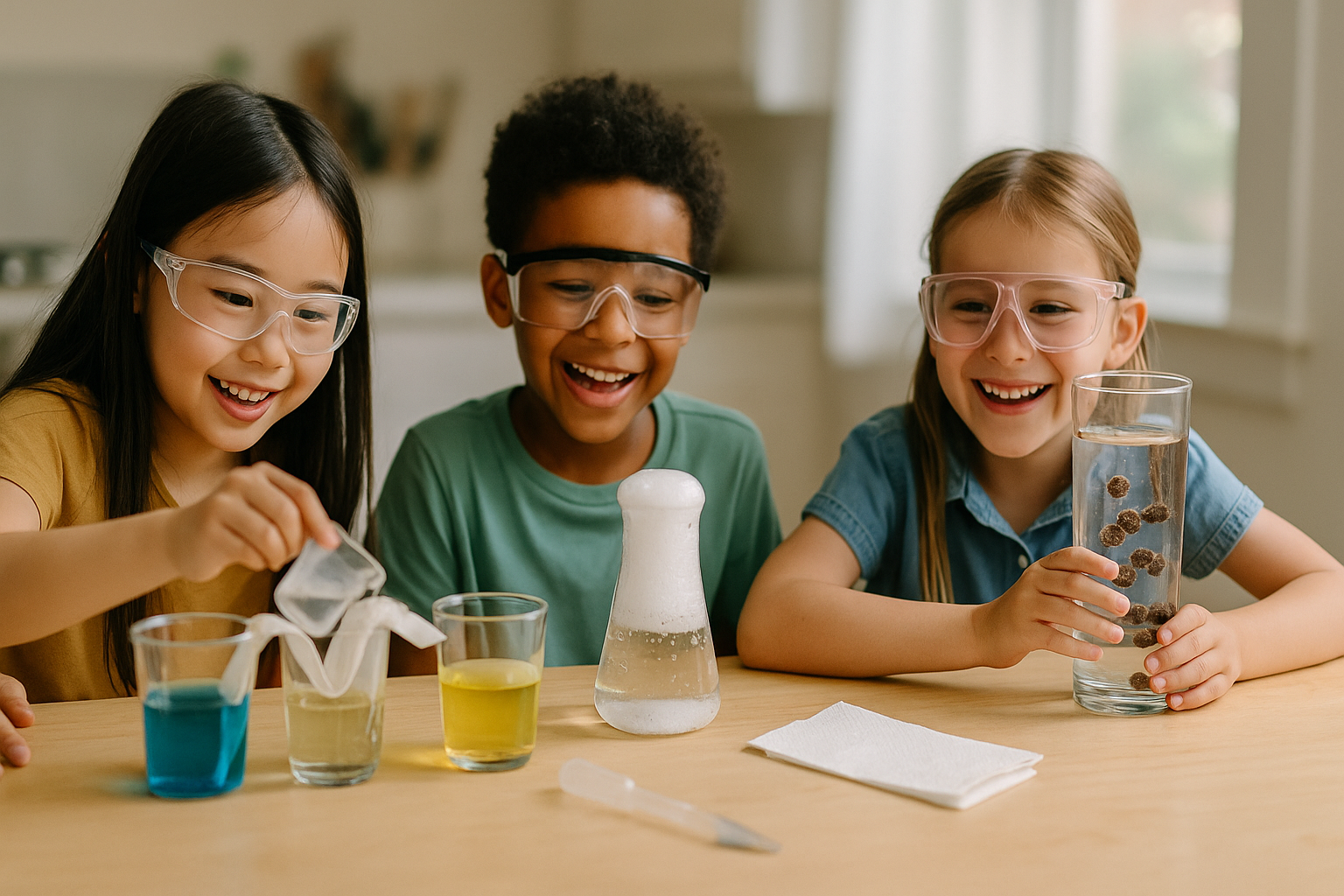Rainy day? Curious kid? Turn your kitchen table into a mini lab with these fun learning experiments. Each activity uses common supplies, takes 5–15 minutes, and includes a one-line “why it works” to build understanding. Try one after school or stack a few for a full afternoon of STEM activities at home. These are perfect science experiments kids will beg to repeat.
Before You Start: Set Up Your Home Lab
- Safety first: Adult supervision, clear workspace, eye protection for splashy projects.
- Starter kit: Baking soda, vinegar, dish soap, food coloring, clear cups, cooking oil, salt, cornstarch, balloons, paper towels.
- Science journal: Keep a simple log: Question → Materials → Steps → What happened → Why.
1) Dancing Raisins
Materials: Clear soda (or sparkling water), clear glass, a handful of raisins.
- Fill the glass with soda.
- Drop in raisins and watch them sink… then rise and “dance.”
Why it works: Bubbles attach to rough raisin surfaces, increasing buoyancy until they float; bubbles pop and the raisins sink again.
Extend: Try pasta, corn kernels, or dried cranberries—compare “dance” times.
2) Pepper & Soap Surface Tension Trick
Materials: Shallow dish, water, ground black pepper, dish soap, cotton swab.
- Cover water’s surface with a sprinkle of pepper.
- Touch the surface with a soap-tipped swab—pepper races to the edges.
Why it works: Soap lowers water’s surface tension; water pulls away from the low-tension point, dragging pepper with it.
Extend: Test different soaps to see which creates the biggest effect.
3) Zip-Bag Volcano (Clean Fizz)
Materials: Zip bag, 2 tbsp baking soda, 1/2 cup vinegar, a squirt of dish soap, food coloring, paper towel.
- Wrap baking soda in a paper-towel “packet.”
- Add vinegar, soap, and color to the bag; gently drop in the packet.
- Seal and set the bag in a tray—watch it puff and fizz.
Why it works: Acid (vinegar) + base (baking soda) → carbon dioxide gas builds pressure and foamy bubbles.
Safety: Don’t overfill; open away from faces.
4) Walking Water Rainbow
Materials: 6 clear cups, paper towels, water, red/yellow/blue food coloring.
- Arrange cups in a circle; fill every other cup with colored water (R, Y, B).
- Fold paper towels into strips and bridge each pair of cups.
- Wait 30–60 minutes for colors to “walk” and mix.
Why it works: Capillary action pulls water up and over through tiny fibers, creating secondary colors in empty cups.
Extend: Try different towel brands or coffee filters and time the flow.
5) DIY Lava Lamp
Materials: Clear bottle, 2/3 cup oil, 1/3 cup water (colored), effervescent tablet.
- Pour oil into the bottle, then colored water.
- Drop in a tablet and watch blobs rise and fall.
Why it works: Oil and water don’t mix (different polarity); tablet releases gas that carries colored water upward.
Safety: Cap loosely; never shake with the tablet still fizzing.
6) Static-Powered Balloon Picks Up Paper
Materials: Balloon, scrap paper pieces, wool sweater or hair.
- Rub the balloon on hair/sweater for 10–15 seconds.
- Hold near paper bits—they leap to the balloon.
Why it works: Rubbing transfers electrons, creating charge that attracts light objects (electrostatic force).
Extend: Test pepper, salt, tiny aluminum foil bits—what sticks best?
7) Oobleck: Solid or Liquid?
Materials: 1 cup cornstarch, ~1/2 cup water, bowl, spoon.
- Mix water into cornstarch until it feels like thick syrup.
- Squeeze hard (it feels solid), then let go (it flows).
Why it works: Oobleck is a non-Newtonian fluid—pressure makes particles lock up; release lets them slide.
Clean-up tip: Scrape into trash; rinse residue with plenty of water (don’t pour big clumps down the drain).
8) Invisible Ink (Heat Reveal)
Materials: Lemon juice, cotton swab, white paper, lamp or warm iron (adult only).
- Write a message with lemon juice; let dry.
- Gently warm paper under a lamp (or ask an adult to iron on low through another sheet) to reveal text.
Why it works: Acidic juice browns faster than paper when heated, making letters appear.
Safety: Adults handle heat; keep paper moving to avoid scorching.
Make It a Mini STEM Fair
- Hypothesis cards: Have kids predict outcomes before each demo.
- Timer & tally: Measure “dance time,” walking-water speed, or fizz height; graph results.
- Explain-back: After each experiment, kids teach the “why” in one sentence.
Conclusion
Curiosity grows with quick wins and clear explanations. Rotate these science experiments kids can master, log observations in a simple journal, and celebrate questions as much as answers. With these STEM activities at home, you’ll turn everyday items into fun learning experiments—and spark a lifelong love of science.
